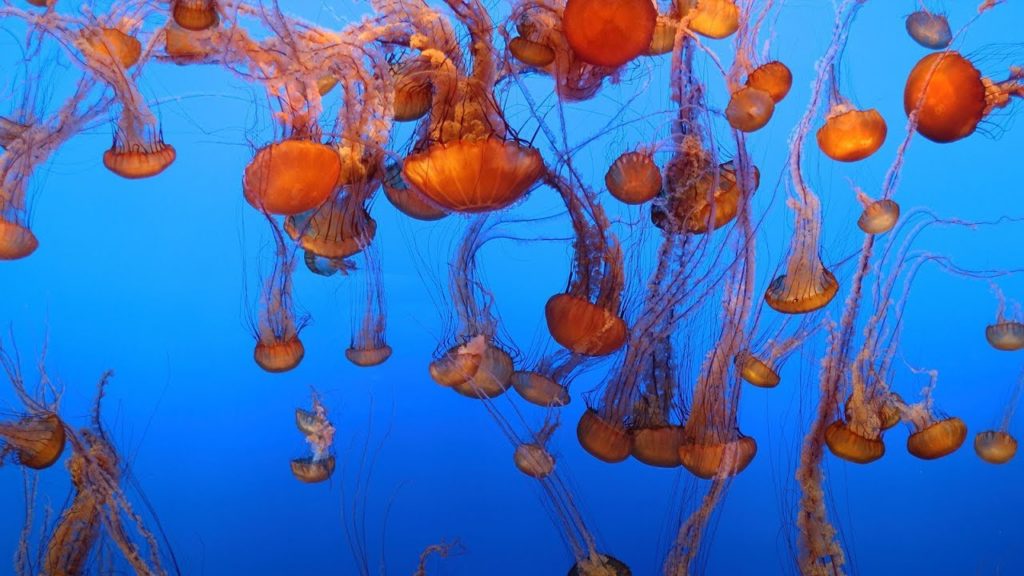
Life can be a little stressful right now. We’ve all been yanked from our daily routine and just going to the grocery store right now can feel like you are in a Mad Max sequel where toilet paper has become the most valuable commodity on earth. Wouldn’t you like to get away for a little while, even if it is through the screen of you computer or mobile device?
If you need a moment of zen, or just a little distraction from trying to find the next series to binge, check out these amazing live cams coming to you from the Monterey Bay Aquarium in California. There are live streams for sharks, jellyfish, penguins, and even one of the actual bay so you can remember what it’s like to be outside for a while.
Get an up-close look at the delicate sea nettles in our Open Sea exhibit. Watch as their long tentacles and lacey mouth-arms move smoothly through the water. But don’t let these unassuming invertebrates fool you—their graceful trailing parts are covered in stinging cells used for hunting. When their tentacles touch tiny drifting prey, the stinging cells paralyze it and stick tight. The prey is moved to the mouth-arms and then to the mouth, where it’s digested.
Our energetic and inquisitive African penguins are visitor favorites. Watch carefully and you might even see them communicating with each other. When penguins flap their wings or bow their heads, they’re telling each other how they feel. Throwing their heads back and wings out means “I’m happy.” Leaning forward and opening their beaks means “Go away.”
Spot sharks, rays and other fishes as they cruise through our rocky reef. Sevengill sharks, leopard sharks, spiny dogfish and the elusive Pacific angel shark all dwell in our Monterey Bay Habitats exhibit—like they do just beyond our walls in the cold waters of the bay. Designed with sharks in mind, this exhibit’s 90-foot-long hourglass shape gives our big sharks plenty of room to glide and turn. Watch carefully and you might see big skates and bat rays pass by the window, just like their shark kin. Plus, keep your eyes peeled for sturgeon coasting through the water, rockfish and giant sea bass relaxing by the reef, and flatfish nestling on the sandy seafloor.
Watch greater Pacific moon jellies (Aurelia labiata) move with the current as they pulse their delicate, translucent bells in our Drifters gallery. Moon Jelly Cam is live every day from 7am to 7pm PST. The several species of moon jellies are common throughout the global ocean. The greater Pacific moon jelly is a seasonal visitor to Monterey Bay, and it can be distinguished by its clear bell, four horseshoe-shaped gonads that are purple or pink when gravid, and a fine mesh of stinging stinging tentacles they use to catch planktonic prey. At the Aquarium, different foods affect their coloration; if they feed extensively on crustaceans, they’ll turn pink or lavender. An orange tint hints that they’ve been feeding on brine shrimp.
Watch our aviary cam carefully—you never know who’ll stroll by. Marvel at the long legs of our black-necked stilt or spot the tiny western snowy plovers that blend into the sand. Look for leg bands on our birds, which help us identify them. Each bird has its own history—most came here injured and can’t live in the wild.
Our Monterey Bay cam offers a peek from the Aquarium’s ocean-view decks. From this vantage point, you can identify a number of the birds and sea mammals that find refuge here. Look for black cormorants perched on a rock, perhaps stretching their wings to dry. Watch the water’s surface; you might see a harbor seal poke its head out of the water, or a sea otter wrapped in kelp. Monterey Bay is part of the Monterey Bay National Marine Sanctuary, a federally protected marine area offshore of California’s central coast. This safe haven is home to a rich variety of fishes, plants, marine mammals and birds.
